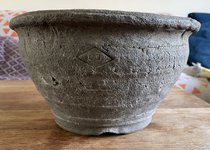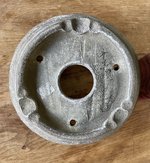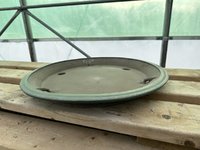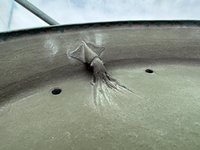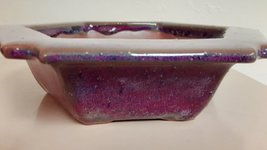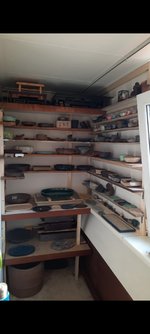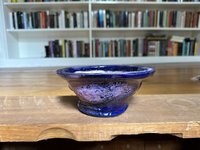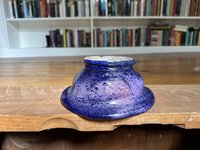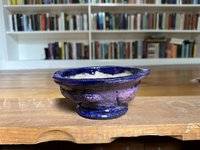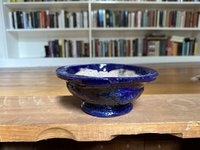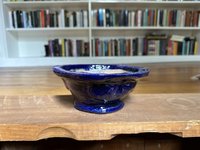You are using an out of date browser. It may not display this or other websites correctly.
You should upgrade or use an alternative browser.
You should upgrade or use an alternative browser.
One of my favorite pots
- Thread starter Dav4
- Start date
Shogun610
Masterpiece
How do you get worms to eat pots? I’m confused
rockm
Spuds Moyogi
Dont' know if you're serious...but "worm eaten" is a texture added to pots to make them look old and distressed, as in worm-eaten wood. It's a technique that is present in many Japanese art media, including metal work. Worm eaten texture lends some "wabi-sabi" flavor to pots.How do you get worms to eat pots? I’m confused
To @Shogun610 ’s defence I didn’t know about it until I purchased this pot last year.Dont' know if you're serious...but "worm eaten" is a texture added to pots to make them look old and distressed, as in worm-eaten wood. It's a technique that is present in many Japanese art media, including metal work. Worm eaten texture lends some "wabi-sabi" flavor to pots.
rockm
Spuds Moyogi
Your Yamaaki is a very good example of this technique. Took a lot of work to get those patches done so they look natural.To @Shogun610 ’s defence I didn’t know about it until I purchased this pot last year.
Canada Bonsai
Chumono
- Messages
- 631
- Reaction score
- 2,181
Looks amazing, but my first feeling was I wouldn’t put a pot in that. Circling roots under the squid.1 of 2 'squid pots' made by Koyo (Mr. Aiba Kouichirou) in 1982
59m x 5.5cm (23.23" x 2.17")
View attachment 482119
View attachment 482120
View attachment 482121
Would love to own it regardless
Shogun610
Masterpiece
Okay so yeah I was serious.. I legit thought they were so old some type of worm in Japan would eat away at the pots if they were like burried on purpose or left somewhere that pests go it themDont' know if you're serious...but "worm eaten" is a texture added to pots to make them look old and distressed, as in worm-eaten wood. It's a technique that is present in many Japanese art media, including metal work. Worm eaten texture lends some "wabi-sabi" flavor to pots.
namnhi
Masterpiece
Nice candy bowl.1 of 2 'squid pots' made by Koyo (Mr. Aiba Kouichirou) in 1982
59m x 5.5cm (23.23" x 2.17")
View attachment 482119
View attachment 482120
View attachment 482121
rockm
Spuds Moyogi
"Mushikui" is the Japanese term for worm holes. You'll see it come up occasionally with Yamaaki kiln pots and among western potters as well. It takes some skill on the potter's part to make it look convincing.Okay so yeah I was serious.. I legit thought they were so old some type of worm in Japan would eat away at the pots if they were like burried on purpose or left somewhere that pests go it them
LittleDingus
Omono
1 of 2 'squid pots' made by Koyo (Mr. Aiba Kouichirou) in 1982
59m x 5.5cm (23.23" x 2.17")
View attachment 482119
View attachment 482120
View attachment 482121
That's an amazing amount of detail for something you wouldn't see in use. I thought maybe drip tray or display bowl...but the tie down and drain holes suggest it's meant to be planted??
I would love to see the squid on the outside as feet maybe.
What am I missing?
Canada Bonsai
Chumono
- Messages
- 631
- Reaction score
- 2,181
What am I missing?
They were both in the potter’s personal collection for 40 years, unused, and it’s unlikely that they will be used while they are in my collection.
There are things like this in all domains: cars, bikes, jewelery, dresses, arms, ancient greek vases, etc. and it’s normally up to the owner whether something should be used or put on display and preserved. I have a number of Koyo pots i’d never use.
Tentakelaertje
Omono
Canada Bonsai
Chumono
- Messages
- 631
- Reaction score
- 2,181
Attachments
The Curator
Seedling
Gorgeous color on this.Here is an unusual pot by Koyo (the late Mr. Aiba Kouichirou).
This was purchased directly from Juko (Mr. Aiba Kuniaki), who confirmed that it was made by his father, Mr. Aiba Kouichirou.
As for the markings: the 'A' is for Aiba, but the significance of the 'X' is unknown by either Juko or Kouso.
View attachment 492961
The Curator
Seedling
Could you use it almost like you would for a slab planting for a forest? Definitely a weird way to use it, but especially with the squids and the color, you could almost make an "island" in the middle.They were both in the potter’s personal collection for 40 years, unused, and it’s unlikely that they will be used while they are in my collection.
There are things like this in all domains: cars, bikes, jewelery, dresses, arms, ancient greek vases, etc. and it’s normally up to the owner whether something should be used or put on display and preserved. I have a number of Koyo pots i’d never use.
Dav4
Drop Branch Murphy
- Messages
- 13,818
- Reaction score
- 34,099
- USDA Zone
- 6a
Oops.... I did it again !
!
Matt O. posted his latest haul on FB a few weeks ago and I couldn't resist. I really, really have a weakness for antique Chinese pots and this one, from the nakawatari era, has apparently been in kokufu and I can see why. The lotus shape, highlighted by over a century of developing patina, is sublime, and the heavy red clay body is so well built... a great pot!

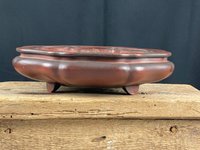
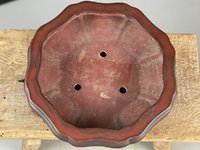

Matt O. posted his latest haul on FB a few weeks ago and I couldn't resist. I really, really have a weakness for antique Chinese pots and this one, from the nakawatari era, has apparently been in kokufu and I can see why. The lotus shape, highlighted by over a century of developing patina, is sublime, and the heavy red clay body is so well built... a great pot!




That really is great pot, jealous.Oops.... I did it again!
Matt O. posted his latest haul on FB a few weeks ago and I couldn't resist. I really, really have a weakness for antique Chinese pots and this one, from the nakawatari era, has apparently been in kokufu and I can see why. The lotus shape, highlighted by over a century of developing patina, is sublime, and the heavy red clay body is so well built... a great pot!
View attachment 495624View attachment 495625View attachment 495626View attachment 495627
Similar threads
- Replies
- 3
- Views
- 2K


